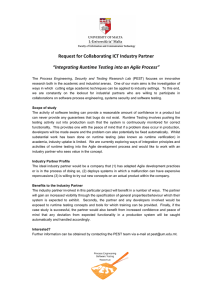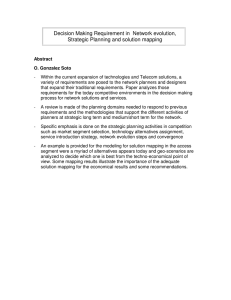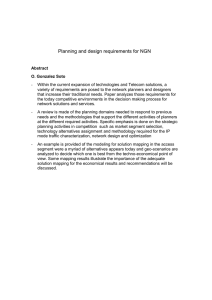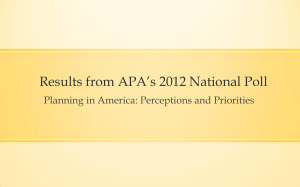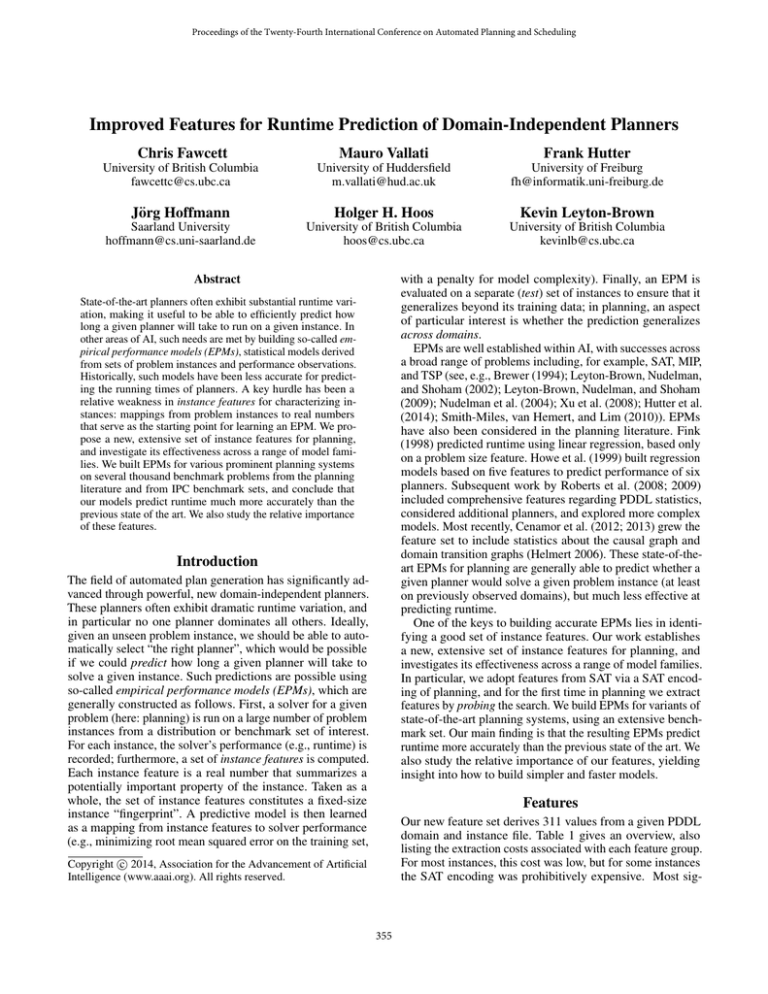
Proceedings of the Twenty-Fourth International Conference on Automated Planning and Scheduling
Improved Features for Runtime Prediction of Domain-Independent Planners
Chris Fawcett
Mauro Vallati
Frank Hutter
University of British Columbia
fawcettc@cs.ubc.ca
University of Huddersfield
m.vallati@hud.ac.uk
University of Freiburg
fh@informatik.uni-freiburg.de
Jörg Hoffmann
Holger H. Hoos
Kevin Leyton-Brown
Saarland University
hoffmann@cs.uni-saarland.de
University of British Columbia
hoos@cs.ubc.ca
University of British Columbia
kevinlb@cs.ubc.ca
Abstract
with a penalty for model complexity). Finally, an EPM is
evaluated on a separate (test) set of instances to ensure that it
generalizes beyond its training data; in planning, an aspect
of particular interest is whether the prediction generalizes
across domains.
EPMs are well established within AI, with successes across
a broad range of problems including, for example, SAT, MIP,
and TSP (see, e.g., Brewer (1994); Leyton-Brown, Nudelman,
and Shoham (2002); Leyton-Brown, Nudelman, and Shoham
(2009); Nudelman et al. (2004); Xu et al. (2008); Hutter et al.
(2014); Smith-Miles, van Hemert, and Lim (2010)). EPMs
have also been considered in the planning literature. Fink
(1998) predicted runtime using linear regression, based only
on a problem size feature. Howe et al. (1999) built regression
models based on five features to predict performance of six
planners. Subsequent work by Roberts et al. (2008; 2009)
included comprehensive features regarding PDDL statistics,
considered additional planners, and explored more complex
models. Most recently, Cenamor et al. (2012; 2013) grew the
feature set to include statistics about the causal graph and
domain transition graphs (Helmert 2006). These state-of-theart EPMs for planning are generally able to predict whether a
given planner would solve a given problem instance (at least
on previously observed domains), but much less effective at
predicting runtime.
One of the keys to building accurate EPMs lies in identifying a good set of instance features. Our work establishes
a new, extensive set of instance features for planning, and
investigates its effectiveness across a range of model families.
In particular, we adopt features from SAT via a SAT encoding of planning, and for the first time in planning we extract
features by probing the search. We build EPMs for variants of
state-of-the-art planning systems, using an extensive benchmark set. Our main finding is that the resulting EPMs predict
runtime more accurately than the previous state of the art. We
also study the relative importance of our features, yielding
insight into how to build simpler and faster models.
State-of-the-art planners often exhibit substantial runtime variation, making it useful to be able to efficiently predict how
long a given planner will take to run on a given instance. In
other areas of AI, such needs are met by building so-called empirical performance models (EPMs), statistical models derived
from sets of problem instances and performance observations.
Historically, such models have been less accurate for predicting the running times of planners. A key hurdle has been a
relative weakness in instance features for characterizing instances: mappings from problem instances to real numbers
that serve as the starting point for learning an EPM. We propose a new, extensive set of instance features for planning,
and investigate its effectiveness across a range of model families. We built EPMs for various prominent planning systems
on several thousand benchmark problems from the planning
literature and from IPC benchmark sets, and conclude that
our models predict runtime much more accurately than the
previous state of the art. We also study the relative importance
of these features.
Introduction
The field of automated plan generation has significantly advanced through powerful, new domain-independent planners.
These planners often exhibit dramatic runtime variation, and
in particular no one planner dominates all others. Ideally,
given an unseen problem instance, we should be able to automatically select “the right planner”, which would be possible
if we could predict how long a given planner will take to
solve a given instance. Such predictions are possible using
so-called empirical performance models (EPMs), which are
generally constructed as follows. First, a solver for a given
problem (here: planning) is run on a large number of problem
instances from a distribution or benchmark set of interest.
For each instance, the solver’s performance (e.g., runtime) is
recorded; furthermore, a set of instance features is computed.
Each instance feature is a real number that summarizes a
potentially important property of the instance. Taken as a
whole, the set of instance features constitutes a fixed-size
instance “fingerprint”. A predictive model is then learned
as a mapping from instance features to solver performance
(e.g., minimizing root mean squared error on the training set,
Features
Our new feature set derives 311 values from a given PDDL
domain and instance file. Table 1 gives an overview, also
listing the extraction costs associated with each feature group.
For most instances, this cost was low, but for some instances
the SAT encoding was prohibitively expensive. Most sig-
c 2014, Association for the Advancement of Artificial
Copyright Intelligence (www.aaai.org). All rights reserved.
355
Class
# succ.
cost
Q50
Q90
# feat.
PDDL domain file
PDDL instance file
PDDL requirements
LPG preprocessing
Torchlight
FDR translation
FDR
Causal&DT graph
FD preprocessing
FD probing
SAT representation
Success & timing
7333
7333
7333
5228
4435
6590
6590
4109
6654
4948
6344
n/a
trivial
trivial
trivial
cheap
cheap
moderate
moderate
moderate
moderate
moderate
expensive
various
0.048
0.048
0.048
0.075
0.029
0.365
0.365
0.409
0.477
1.419
7.802
n/a
0.075
0.075
0.075
3.230
0.671
33.205
33.205
35.134
40.722
34.295
1800
n/a
18
7
24
6
10
19
19
41
8
16
115
28
Total
–
–
–
–
311
LPG preprocessing. For this extractor, we run LPG-td
(Gerevini, Saetti, and Serina 2003) until the end of its preprocessing. We extract features such as the number of facts, the
number of “significant” instantiated operators and facts, and
the number of mutual exclusions between facts. (As LPG is
highly parameterized, it is difficult to design search probes
as we do for FD; we leave this open for future work.)
Torchlight. We restrict ourselves to Torchlight’s searchsampling variant, as this was most robust (highest success
rate) across our instance set. We extract success (sample state
proved to not be a local minimum) and dead-end percentages, and statistics on exit distance bounds as well as the
preprocessing.
FD probing. We run Fast Downward for 1 CPU second,
using the same heuristic settings as for LAMA, and measure
features from the resulting planning trajectory, such as the
number of reasonable orders removed, landmark discovery
and composition, the number of graph edges, the number
of initial and goal landmarks, and statistics on and relative
improvement over the initial and final heuristic values.
Table 1: Summary of our features, by class (the classes are
explained in the text). “# succ.” is the number of instances
(out of 7571) for which the feature was successfully extracted.
“cost” is the “cost class” of each extractor used in Tables 3
and 4. “Q50” and “Q90” are the median and 90% quantile
of the extraction times (in CPU seconds) for the entire class,
assuming that no other features have been extracted.
SAT representation. We use the SAT translation of Mp (Rintanen 2012) to produce a CNF with a planning horizon of 10.
If the creation of this instance is successful, we use the SAT
feature extraction code of SATzilla 2012 (Xu et al. 2012) to
extract 115 features from 12 classes: problem size features,
variable-clause graph features, variable graph features, clause
graph features, balance features, as well as features based on
proximity to Horn formula, DPLL probing, LP-based, local
search probing, clause learning, and survey propagation (see
Hutter et al. (2014) for details on these classes).
nificantly, we introduce so-called probing features for planning based on information gleaned from (short) runs of Fast
Downward (Helmert 2006). We also employ instance features based on Torchlight, a recent tool for analyzing local
search topology under h+ (Hoffmann 2011). Furthermore,
we employ SAT-based feature extractors, leveraging extensive prior work on EPMs in that area. Overall, our features
fall into the following eight groups.
PDDL. We extend the 16 PDDL domain features, 3 instance
features, and 13 language requirement features explored by
Roberts et al. (2008) with 2 additional domain features covering the use and number of object types, and 4 additional
instance features adding information about constants, “=”
predicate usage, and function assignments in initial conditions. We also add 11 additional language requirement features from newer versions of the PDDL specification.
Success & timing. For each of our seven extraction procedures, we record whether extraction was successful (a binary
feature) and record as a numeric feature the CPU time required for extraction. The SAT feature extractors additionally
report 10 more timing features for extraction time of various
subcomponents.
FDR. We use the translation and preprocessing tools built
into Fast Downward to translate the given PDDL domain and
instance into the finite domain representation used by Fast
Downward (and for extracting our “FD probing” features).
We gather features from the console output of the translation process (such as the number of removed operators and
propositions and number of implied preconditions added),
the finite domain representation created (such as the number
of variables, number of mutex groups, and statistics over
operator effects), as well as from the output of the preprocessing process (such as the percentage of variables, mutex
groups and operators deemed necessary, whether the instance
is deemed solvable in polynomial time, and the resulting task
size).
All planners and feature extractors were run on a cluster
with computing nodes equipped with two Intel Xenon X5650
hexacore CPUs with 12MB of cache and 24GB of RAM each,
running Red Hat Enterprise Linux Server 5.3. Each of our
runs was limited to a single core, and was given runtime and
memory limits of 1800 CPU seconds and 8GB respectively,
as used in the deterministic tracks of recent IPCs.
For each planner run, we recorded the overall result: success (found a valid plan or proved unsolvable),
crashed, timed-out, ran out of memory, or unsupported instance/domain. Unsuccessful planner runs were assigned a
runtime equal to the 1800 second cutoff.
Experiment Design and Methodology
Benchmarks and Planners. We selected variants of seven
planners, based on their outstanding performance in various tracks of previous IPCs and/or the use of very different
planning approaches (see Table 2).
Fast Downward has many configurations; we use the same
default configuration as in previous work (Fawcett et al. 2011;
Causal and DT graph. Using the finite domain representation created in the extraction of our “FDR” features, we
extract the 41 features of the causal and domain transition
graphs introduced by Cenamor et al. (2012; 2013).
356
Planner
Literature
Arvand
Fast Downward
FF
LAMA
LPG
Mp
Probe
Nakhost et al. (2011)
Helmert (2006), Seipp et al. (2012)
Hoffmann and Nebel (2001), Hoffmann (2003)
Richter and Westphal (2008), Richter et al. (2011)
Gerevini, Saetti, and Serina (2003)
Rintanen (2012)
Lipovetzky and Geffner (2011)
IPC
2011
2011
2002,2004
2008,2011
2002,2004
2011
2011
Table 2: Overview of the planners in our experiments.
Seipp et al. 2012). We consider three versions of FF: the
standard FF v2.3 (Hoffmann and Nebel 2001), FF-X which
supports derived predicates (Thiébaux, Hoffmann, and Nebel
2005), and Metric-FF which supports action costs (Hoffmann
2003). We include the default version of LPG as well as a
version (LPG-contra) allowing the instantiation of actions
with the same objects for multiple parameters if permitted by
the domain.
We gathered as many available PDDL planning instances
as possible, with the only restriction being that they were
supported (but not necessarily solvable) by at least one of
the planners used in our study. Considering all different encodings available for the same planning problem, we ended
up with a set of 7571 planning instances collected from the
following sources: (i) IPC’98 and IPC’00; (ii) deterministic tracks of IPC’02 through IPC’11 and learning tracks of
IPC’08 and IPC’11 (demo problems and learning problems,
when provided by the organizers); (iii) FF benchmark library; (iv) Fast Downward benchmark library; (v) UCPOP
Strict benchmarks, and; (vi) Sodor and Stek domains used by
Roberts et al. (2008).
Planner
RMSE of log10 (runtime)
None DF +IF +LF +NF-0 +Ce +NF-1 +NF-2
Arvand
Fast Downward
FF v2.3
FF-X
LAMA
LPG
LPG-contra
Metric-FF v2.1
Mp
Probe
1.69
1.64
2.44
2.41
1.61
2.00
2.00
2.37
2.28
2.14
1.07
0.98
1.44
1.45
1.00
1.1
1.11
1.51
1.43
1.27
0.67
0.6
0.81
0.73
0.63
0.55
0.55
0.77
0.61
0.61
0.65
0.58
0.81
0.73
0.61
0.53
0.55
0.78
0.62
0.6
0.68
0.61
0.82
0.75
0.64
0.54
0.57
0.79
0.63
0.6
0.47 0.41
0.38 0.37
0.79 0.69
0.72 0.62
0.44 0.38
0.51 0.44
0.53 0.45
0.76 0.68
0.62 0.54
0.59 0.51
0.39
0.34
0.67
0.59
0.35
0.41
0.43
0.64
0.51
0.50
All
0.37
0.34
0.64
0.53
0.32
0.42
0.43
0.61
0.41
0.45
Table 3: Cross-validated RMSE of log10 (runtime) for random forest models using feature subsets that are increasingly expensive to extract. The table shows 10-fold crossvalidated performance using a uniform random permutation of our entire set of 7571 problem instances. Column
‘None’ gives the performance of a featureless mean predictor. The following three subsets contain the 32 features used
by Roberts et al. (2008): PDDL domain features only (DF),
DF plus PDDL instance features (IF), and IF plus PDDL
requirements features (LF). In the remaining four subsets,
NF-0 is comprised of the 32 previous PDDL features plus
an additional 17 produced by our extractors, Ce additionally includes the graph features by Cenamor et al. (2012;
2013), NF-1 the features marked “cheap” in Table 1, and NF2 the features marked “moderate”. Finally, the All column
also includes the features marked “expensive”, and contains
all of our 311 features. Bold text indicates the best result, or
results that are not statistically significantly different from
the best result across the cross-validation folds.
are also automatic feature selectors, we used them for the
remainder of the paper. Next, we describe experiments for
our full 7571-instance set.
Building Empirical Performance Models. Using the EPM
construction process outlined by Hutter et al. (2014), we performed experiments with different planners, different benchmark sets and different cross-validation approaches. Due to
the fact that the runtimes of our planners varied from 0.01
CPU seconds to near the full 1800 second runtime cutoff, in
all cases we trained our models to predict log-runtime rather
than absolute runtime. This log-transformation has been previously demonstrated to be highly effective under similar
circumstances (e.g., by Hutter et al. (2014)). We investigate
two cross-validation approaches: 10-fold cross-validation on
a uniform random permutation of our instances (a standard
method where nine slices are used for training and the tenth
for testing), as well as leave-one-domain-out cross-validation
where we train on instances from all domains but one, and
test on the held-out domain, for each of the 180 domains in
our instance set (the same methods were used by Cenamor
et al. (2012)). First, we assessed the performance of various regression models (linear regression, neural networks,
Gaussian processes, regression trees, and random forests)
using the data by Roberts et al. (2008). While all models
were competitive with the nearest neighbour approach by
Roberts et al. (2008), consistent with the findings of Hutter et
al. (2014), random forests performed best (somewhat better
than the nearest neighbour approach). Since random forests
Experiments: Runtime Prediction
Table 3 gives detailed performance results for prediction using our random forest models, with 10-fold cross-validation
on a uniform random permutation of our full set of 7571
problem instances. Table 4 shows results for the equivalent
experiment using leave-one-domain-out cross-validation. Unlike for the “challenge 3” instance set used by Roberts et
al. (2008), on this (harder) set of instances the PDDL domain features are no longer sufficient for achieving good
prediction accuracy, and neither is the set of all PDDL
features. Our features achieve substantially lower RMSE,
even in the more challenging leave-one-domain-out scenario. We note further that in all scenarios our features
achieve lower RMSE than the combined sets of features
from Roberts et al. (2008) and Cenamor et al. (2012;
2013).
Figure 1 compares predicted vs. observed runtime across
our entire set of problem instances using the models from
Table 3 for the LAMA planner. These plots illustrate the
improvement in accuracy gained from our larger feature set
over the 32 PDDL features used by Roberts et al. (2008),
357
None DF +IF
RMSE of log10 (runtime)
+LF +NF-0 +Ce +NF-1 +NF-2
Arvand
Fast Downward
FF v2.3
FF-X
LAMA
LPG
LPG-contra
Metric-FF v2.1
Mp
Probe
1.61
1.55
2.5
2.47
1.53
1.89
1.89
2.36
2.23
2.08
0.82
0.58
1.02
1.01
0.73
0.83
0.9
0.93
0.99
0.98
1.45
1.14
1.7
1.75
1.35
1.53
1.52
1.88
1.9
1.78
0.92
0.61
1.05
1.05
0.86
0.99
1.00
0.99
0.99
0.98
0.89
0.63
1.04
1.03
0.82
0.86
0.89
1.05
1.02
0.98
0.79
0.45
1.00
1.01
0.66
0.86
0.91
1.04
0.97
0.96
0.83
0.46
0.93
0.92
0.69
0.55
0.57
0.95
1.03
0.82
0.65
0.32
0.82
0.79
0.54
0.59
0.61
0.90
0.90
0.84
0.8
0.7
All
0.6
0.61
0.31
0.71
0.69
0.49
0.62
0.62
0.78
0.47
0.69
RMSE
Planner
3
0
2
Predicted runtime [s]
Predicted runtime [s]
1
10
0
−1
2
10
1
10
−1
10
−1
10
0
10
1
10
2
10
3
10
True runtime [s]
(a) LAMA, PDDL features
−1
10
0
10
1
10
2
10
8
10
identify properties of an instance that strongly influence
runtime. In practice, such an analysis is complicated by
two hurdles. First, many models (such as random forests)
are complex, making them difficult for humans to understand. Second, features are often strongly correlated, making it difficult to assess feature importance by looking at
individual features’ effects on model performance. (For
example, a natural way of assessing importance is measuring the amount model performance suffers by omitting
each feature; when features are correlated, this method
fails badly.) We therefore investigated which features were
most informative for runtime prediction by using forward
selection (Leyton-Brown, Nudelman, and Shoham 2002;
Hutter, Hoos, and Leyton-Brown 2013). This method starts
with a 0-feature model and then repeatedly greedily adds
the feature that most improves RMSE. This avoids highly
correlated features; a small, easy-to-understand model may
be obtained by stopping this process before performance
stops increasing substantially at each step. We quantify a
feature’s importance as the increase in RMSE when omitting
the feature from that small model. In our experiments, we
ran forward selection for 10 steps, averaging feature importance measurements across ten forward selection runs for
each planner.
Figure 2 shows the impact of the top 10 features on RMSE
for runtime models for LAMA. Observe that the first few
features were already sufficient to achieve nearly the same
accuracy as the full model; the same pattern also held for
our other planners. There is not a unique subset of important
features shared by all planners. Features from each of our
categories are important for all of the planners we study,
but the exact features selected differ across planners: for
FD-based planners FDR-based features work well, but FDprobing, LPG-preprocessing and SAT features were selected
for many of the planners. Timing and Torchlight features
were generally less important. The reasons for this deserve
further investigation, but likely include Torchlight’s relative
lack of robustness.
Tables 3 and 4 assess the computational cost of feature extraction, considering increasingly costly feature sets. Overall,
“cheap” features were usually sufficient for outperforming
the previous state of the art, and “moderate” features often
came close to the performance of our full model. In some
cases—in particular Mp, for which the (“expensive”) SAT
10
10
6
Figure 2: RMSE across number of features in greedy forward
selection (LAMA, 10-fold cross-validation).
0
10
4
Feature subset size
3
2
0.3
0.1
10
10
0.4
0.2
Table 4: Cross-validated RMSE of log10 (runtime) obtained
using the same process as for Table 3, but performing leaveone-domain-out cross-validation across all 180 problem domains. Note that means and statistical tests are taken over
these 180 folds (i.e., domains with few and many problems
have equal weight).
10
0.5
3
10
True runtime [s]
(b) LAMA, All features
Figure 1: Scatter plots comparing predicted to actual runtime
of LAMA on our full set of instances, using 10-fold crossvalidation. (a) shows performance for a model using only the
32 PDDL features from Roberts et al. (2008); (b) shows the
improved performance using our full set of 311 features.
both for 10-fold and leave-one-domain-out cross-validation.
We note that many points in those plots lie close to the main
diagonal, indicating accurate predictions: For LAMA and
10-fold cross-validation, 90.5% of our predictions are within
a factor of 2 of the observed runtimes with our full feature
set, vs. 83.1% when using the PDDL features of Roberts et al.
(2008) and 88.1% when using the PDDL features plus those
of Cenamor et al. (2012; 2013). For the leave-one-domainout scenario, the corresponding numbers are 69.8% vs. 54.0%
and 62.5%. We observed qualitatively similar results for the
other planners.
If we sort the instances in our set by hardness (approximated by the runtime required for LAMA to solve them), for
all planners the RMSE for the easier half of the instances
is lower than for the harder half. In the case of LAMA and
10-fold cross-validation, the resulting RMSE values are 0.198
and 0.420, respectively.
Experiments: Feature Importance
EPMs are valuable beyond their ability to make performance predictions: an effective model can be examined to
358
representation features are of course important—adding expensive features significantly improved model performance.
Hoffmann, J. 2011. Analyzing search topology without running any
search: On the connection between causal graphs and h+. Journal
of Artificial Intelligence Research 41:155–229.
Howe, A.; Dahlman, E.; Hansen, C.; Von Mayrhauser, A.; and
Scheetz, M. 1999. Exploiting competitive planner performance. In
Proceedings of the 5th European Conference on Planning (ECP-99),
62–72.
Hutter, F.; Xu, L.; Hoos, H. H.; and Leyton-Brown, K. 2014. Algorithm runtime prediction: Methods & evaluation. Artificial Intelligence 206:79–111.
Hutter, F.; Hoos, H. H.; and Leyton-Brown, K. 2013. Identifying key
algorithm parameters and instance features using forward selection.
In Proceedings of the 7th International Conference on Learning and
Intelligent Optimization (LION 7), 364–381.
Leyton-Brown, K.; Nudelman, E.; and Shoham, Y. 2002. Learning the empirical hardness of optimization problems: The case of
combinatorial auctions. In Principles and Practice of Constraint
Programming - CP 2002, 556–572.
Leyton-Brown, K.; Nudelman, E.; and Shoham, Y. 2009. Empirical
hardness models: methodology and a case study on combinatorial
auctions. Journal of the ACM 56(4):1–52.
Lipovetzky, N., and Geffner, H. 2011. Searching for plans with
carefully designed probes. In Proceedings of the 21st International
Conference on Automated Planning and Scheduling (ICAPS 2011),
154–161. AAAI press.
Nakhost, H.; Müller, M.; Valenzano, R.; and Xie, F. 2011. Arvand:
the art of random walks. In Booklet of the 7th International Planning
Competition.
Nudelman, E.; Leyton-Brown, K.; Devkar, A.; Shoham, Y.; and
Hoos, H. 2004. Understanding random SAT: Beyond the clauses-tovariables ratio. In Principles and Practice of Constraint Programming - CP 2004, 438–452.
Rintanen, J. 2012. Engineering efficient planners with SAT. In Proceedings of the 20th European Conference on Artificial Intelligence
(ECAI 2012), 684–689.
Roberts, M., and Howe, A. 2009. Learning from planner performance. Artificial Intelligence 173(5-6):536–561.
Roberts, M.; Howe, A. E.; Wilson, B.; and desJardins, M. 2008.
What makes planners predictable? In Proceedings of the 18th
International Conference on Automated Planning and Scheduling
(ICAPS 2008), 288–295.
Seipp, J.; Braun, M.; Garimort, J.; and Helmert, M. 2012. Learning
portfolios of automatically tuned planners. In Proceedings of the
22nd International Conference on Automated Planning & Scheduling (ICAPS 2012), 369–372.
Smith-Miles, K.; van Hemert, J.; and Lim, . X. Y. 2010. Understanding TSP difficulty by learning from evolved instances. In
Proceedings of the 4th International Conference on Learning and
Intelligent Optimization (LION 4), 266–280.
Thiébaux, S.; Hoffmann, J.; and Nebel, B. 2005. In defense of
PDDL axioms. Artificial Intelligence 168(1):38–69.
Xu, L.; Hutter, F.; Hoos, H. H.; and Leyton-Brown, K. 2008.
SATzilla: Portfolio-based algorithm selection for SAT. Journal
of Artificial Intelligence Research 32:565–606.
Xu, L.; Hutter, F.; Shen, J.; Hoos, H.; and Leyton-Brown, K. 2012.
SATzilla2012: Improved algorithm selection based on cost-sensitive
classification models. Solver description, SAT Challenge 2012.
Conclusions
Predicting performance is an important research direction
in its own right, and also offers huge potential for practical improvements to solver performance via intelligent
per-instance solver selection, as amply demonstrated by
the success of SATzilla (Xu et al. 2008) in SAT. Improvements in prediction depend critically on stronger features, which we consider to be a gaping hole in the planning literature. Recent attempts by Cenamor et al. (2012;
2013) made valuable progress by considering causal graph
and DTG structures; the use of Torchlight (Hoffmann 2011)
permits deeper analysis of these same structures. But no previous work took the (in retrospect obvious) step of designing
features based on search probing and SAT encodings. We
close that part of the hole in this work, designing a comprehensive feature set, and conducting extensive experiments
showing that significant improvements can be obtained in
the accuracy of runtime prediction. Our next steps will be
to further extend our feature collection, and to engineer a
portfolio approach exploiting its predictions. We believe that
a comprehensive feature set will be important for many other
purposes as well, such as the recent methods for learning
macro actions by Alhossaini and Beck (2012).
References
Alhossaini, M., and Beck, J. 2012. Macro learning in planning
as parameter configuration. In Proceedings of the 25th Canadian
Conference on Artificial Intelligence, 13–24.
Brewer, E. A. 1994. Portable high-performance supercomputing:
high-level platform-dependent optimization. Ph.D. Dissertation,
Massachusetts Institute of Technology.
Cenamor, I.; de la Rosa, T.; and Fernández, F. 2012. Mining
IPC-2011 results. In Proceedings of the 3rd workshop on the International Planning Competition.
Cenamor, I.; de la Rosa, T.; and Fernández, F. 2013. Learning
predictive models to configure planning portfolios. In Proceedings
of the 4th workshop on Planning and Learning (ICAPS-PAL 2013),
14–22.
Fawcett, C.; Helmert, M.; Hoos, H. H.; Karpas, E.; Röger, G.; and
Seipp, J. 2011. FD-Autotune: Domain-specific configuration using
Fast Downward. In Proceedings of the 3rd workshop on Planning
and Learning (ICAPS-PAL 2011), 13–20.
Fink, E. 1998. How to solve it automatically: Selection among
problem-solving methods. In Proceedings of the Fourth International Conference on Artificial Intelligence Planning Systems, 128–
136.
Gerevini, A.; Saetti, A.; and Serina, I. 2003. Planning through
stochastic local search and temporal action graphs. Journal of
Artificial Intelligence Research 20:239–290.
Helmert, M. 2006. The Fast Downward planning system. Journal
of Artificial Intelligence Research 26:191–246.
Hoffmann, J., and Nebel, B. 2001. The FF planning system: Fast
plan generation through heuristic search. Journal of Artificial Intelligence Research 14:253–302.
Hoffmann, J. 2003. The Metric-FF planning system: Translating
“ignoring delete lists” to numeric state variables. Journal of Artificial
Intelligence Research 20:291–341.
359


